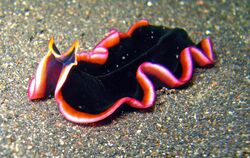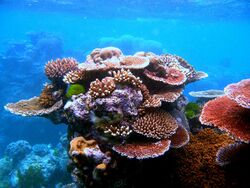Biology:Pseudocerotidae
Pseudocerotidae is a family of flatworms which includes the Bedford's flatworm. Pseudocerotidae are simple organisms categorized by their oval bodies and tentacles[1] and bright colors. They use the cilia to glide along surfaces.[2] Most commonly referred to as marine flatworms, closely related to the orders Macrostomorpha and Lecithoepitheliata. These organisms have very complex reproductive systems,[3] no blood systems or organs for gas exchange, a simple brain and are hermaphroditic.[4]
| Pseudocerotidae | |
|---|---|

| |
| Pseudobiceros hancockanus This image shows a species of marine flatworm showing prominent False Horns. | |
| Scientific classification | |
| Domain: | Eukaryota |
| Kingdom: | Animalia |
| Phylum: | Platyhelminthes |
| Order: | Polycladida |
| Suborder: | Cotylea |
| Family: | Pseudocerotidae Lang, 1884 |
| Genera | |
| |
Habitat
Due to the anthropogenic transportation of non-native marine species, their species can be found all around the world in tropical and subtropical waters near coral reefs,[11] shallow reefs, deep waters, water surfaces and in aquaculture areas.[12] The most biodiverse areas with these species are the Caribbean and Indo-Pacific regions.[13]
Diet
The feeding methods of pseudocerotidae are most intriguing, due to their soft bodies and slow movements they must prey on other organisms with little to no movement. This is why their diet is composed of scavenging for various sponges, other stationary or dead invertebrates. They use their sensory detectors to chemically sense their food. The food is digested before entering the body. Then the food travels through their pharynx, "...which can then grow to be the size of the whole flatworm".[14]
Phenology
Polycladia are typically distinguished by their hermaphroditic reproductive system and their external anatomy such as their eyespot arrangement, pharynx and tentacles.[12] In an experiment Pseudoceros and Pseudobiceros were previously based on their reproductive systems, the two groups of Pseudocerotidae were divided into groups through their genetic difference. A difference in an expansive segment of 28S rDNA, showed small genetic difference in the species Pseudoceros bifurcus.[15]
Reproduction
Penis fencing is not purely for reproduction and is not an aggressive battle of insemination, it is a mating ritual that can result in insemination of both individuals willfully. A few species show long term care for their young, this care is typically shown in species that have smaller offspring sizes. While larger offspring sizes with faster development in species cause little care for the young after birth. The egg capsules produced are most commonly smooth and round, except for a few species where they have pointed opercula.[16] Egg capsules can reach thousands, in a study the number of eggs for two different flatworms were 1,307 and 3,073.[17]
References
- ↑ "Family Pseudocerotidae". http://species-identification.org/species.php?species_group=turbellaria&menuentry=groepen&id=84&tab=beschrijving.
- ↑
- ↑ "Phylum Platyhelminthes - flatworms". https://seanet.stanford.edu/Platyhelminthes.
- ↑ Ramel, Gordon (18 February 2020). "Turbellaria: Tiny, Non-Parasitic Flatworms Including Acoela & Tricladida". https://earthlife.net/inverts/turbellaria.[self-published source?]
- ↑ Collingwood, Dr. (July 1876). "VI. On thirty-one Species of Marine Planarians, collected partly by the late Dr. Kelaart, F.L.S., at Trincomalee, and partly by Dr. Collingwood, F.L.S., in the Eastern Seas.". Transactions of the Linnean Society of London. 2nd Series: Zoology 1 (3): 83–98. doi:10.1111/j.1096-3642.1876.tb00435.x. https://zenodo.org/record/2150060.
- ↑ Newman, Leslie J.; Cannon, Lester R. G. (1996). "Bulaceros, new genus, and Tytthosoceros, new genus (Platyhelminthes: Polycladida) from the Great Barrier Reef, Australia and Papua New Guinea". Raffles Bulletin of Zoology 44 (2): 479–492. https://lkcnhm.nus.edu.sg/app/uploads/2017/06/44rbz479-492.pdf. Retrieved 11 April 2020.
- ↑ 7.0 7.1 Newman, Leslie J.; Cannon, Lester R. G. (1996). "New genera of pseudocerotid flatworms (Platyhelminthes; Polycladida) from Australian and Papua New Guinean coral reefs". Journal of Natural History 30 (10): 1425–1441. doi:10.1080/00222939600770811.
- ↑ 8.0 8.1 Faubel, A. (1984). "The Polycladida, Turbellaria; Proposal and establishment of a new system. Part 2. The Cotylea". Mitteilungen aus dem Hamburgischen Zoologischen Museum und Institut 81: 189–259. NAID 10010536160.
- ↑ Hyman, Libbie H. (1959). "A further study of Micronesian polyclad flatworms". Proceedings of the United States National Museum 108 (3410): 543–597. doi:10.5479/si.00963801.108-3410.543. https://www.biodiversitylibrary.org/part/7099.
- ↑ 10.0 10.1 Lang, A (1884). "Die Polycladen des Golfes von Neapel und der angrenzenden Meeresabschnitte. Eine Monographie.". Fauna und Flora des Golfes von Neapel, Leipzieg 11. https://www.biodiversitylibrary.org/item/41689#page/7/mode/1up. Retrieved 11 April 2020.
- ↑ Khalili, Zahra; Rahimian, Hassan; Pazooki, Jamile (28 December 2009). "First record of the family Pseudocerotidae (Platyhelminthes, Polycladida, Cotylea) from the Persian Gulf, Iran". ZooKeys (31): 39–51. doi:10.3897/zookeys.31.136.
- ↑ 12.0 12.1 Dixit, Sudhanshu; Bulnes, Verónica N.; Raghunathan, Chelladurai (27 September 2018). "Neotype Designation for the Marine Flatworm, Acanthozoon alderi(Polycladida: Cotylea: Pseudocerotidae), from India with Comments on theTaxonomical Status of the Genus". Zoological Studies 57: e45. doi:10.6620/ZS.2018.57-45. PMID 31966285.
- ↑ Dixit, Sudhanshu; Manjebrayakath, Hashim; Saravanane, Narayanane (March 2021). "Two new Pseudoceros (Platyhelminthes: Polycladida: Pseudocerotidae) from Agatti Island, India and a species checklist from Indian waters". Journal of the Marine Biological Association of the United Kingdom 101 (2): 253–263. doi:10.1017/S0025315421000151.
- ↑ "Pseudoceros Bifurcus". http://bioweb.uwlax.edu/bio203/s2014/tran_tram/classification.htm.[|permanent dead link|dead link}}]
- ↑ Litvaitis, M. K.; Newman, L. J. (2001). "A molecular framework for the phylogeny of the Pseudocerotidae (Platyhelminthes, Polycladida)". Hydrobiologia 444 (1/3): 177–182. doi:10.1023/A:1017503124908.
- ↑ Tong, Samantha Jia Wen; Ong, Rene S.L. (June 2020). "Mating behavior, spawning, parental care, and embryonic development of some marine pseudocerotid flatworms (Platyhelminthes: Rhabditophora: Polycladida) in Singapore". Invertebrate Biology 139 (2). doi:10.1111/ivb.12293.
- ↑ Chim, C. K.; Ong, Rene SL; Gan, B. Q. (2015). "Penis fencing, spawning, parental care and embryonic development in the cotylean flatworm Pseudoceros indicus (Platyhelminthes: Polycladida: Pseudocerotidae) from Singapore". Raffles Bulletin of Zoology. https://lkcnhm.nus.edu.sg/wp-content/uploads/sites/10/app/uploads/2017/06/S31rbz060-067.pdf.
External links
- Wells, Fred (2019). "A low number of introduced marine species in the tropics: a case study from Singapore". Management of Biological Invasions 10 (1): 23–45. doi:10.3391/mbi.2019.10.1.03. ProQuest 2285117784.
- "Pseudocerotidae". Integrated Taxonomic Information System. https://www.itis.gov/servlet/SingleRpt/SingleRpt?search_topic=TSN&search_value=54176. Retrieved 16 February 2006.
Wikidata ☰ Q3385052 entry
 |



